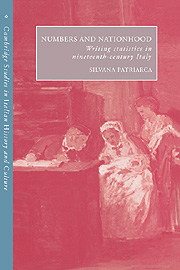Book contents
- Frontmatter
- Contents
- List of illustrations
- Acknowledgments
- Map 1 Italy during the process of unification
- 1 Introduction
- 2 A science for the “civilizing” of nations
- 3 The logics of statistical description
- 4 Official numbers
- 5 “Patriotic” statistics
- 6 The identity of the Italians
- 7 A map of the new nation
- 8 Center and periphery
- 9 Epilogue
- Appendix: Numbers of statistical publications
- Select bibliography
- Index
6 - The identity of the Italians
Published online by Cambridge University Press: 14 October 2009
- Frontmatter
- Contents
- List of illustrations
- Acknowledgments
- Map 1 Italy during the process of unification
- 1 Introduction
- 2 A science for the “civilizing” of nations
- 3 The logics of statistical description
- 4 Official numbers
- 5 “Patriotic” statistics
- 6 The identity of the Italians
- 7 A map of the new nation
- 8 Center and periphery
- 9 Epilogue
- Appendix: Numbers of statistical publications
- Select bibliography
- Index
Summary
We have seen how Italian patriotic statisticians, in order to escape the stereotyped images of the peninsula which stressed the torpor and misery of its inhabitants, highlighted by means of numbers and “facts” the signs of progress, the dynamic elements that made the Italian people worthy of the place they were claiming among the industrious and civilized countries of Europe. Yet there were statistics that could be used to support exactly the kind of stereotyping that Italian patriots were trying to avoid; this was particularly the case of “moral statistics”, namely the counting of crimes, suicides, foundlings, and all sorts of signs of disorderly, “immoral” lives, in order to evaluate the morality of a society. From the time of their emergence in the late 1820s moral statistics promised to be a powerful new instrument for ranking peoples and states, or for drawing boundaries within established ones. Lower or higher percentages of violent crimes or of suicides seemed to represent the moral fabric of a society in a way which was both evocative and authoritative, and spoke to the concern about the nature of modern society that gripped the nineteenth-century elites.
Although crime was monitored and counted both in the pre-unification states and then in the Kingdom of Italy, the first extended essay on moral statistics bearing on the Italians was published as late as 1865–1866, in Venice.
- Type
- Chapter
- Information
- Numbers and NationhoodWriting Statistics in Nineteenth-Century Italy, pp. 155 - 175Publisher: Cambridge University PressPrint publication year: 1996

